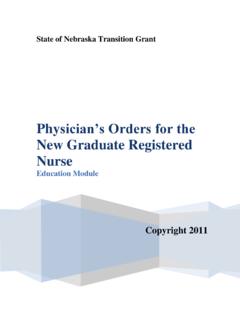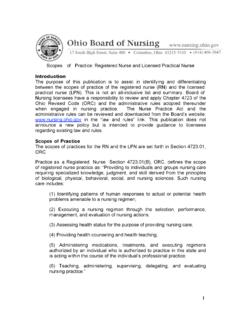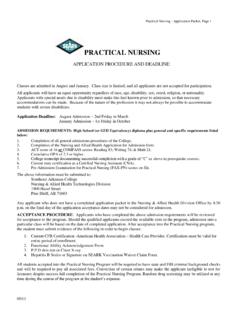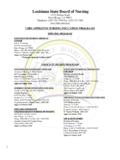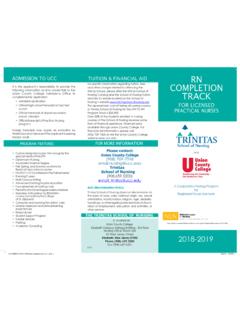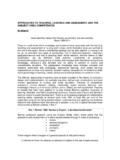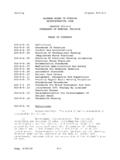Transcription of Newly Licensed Practical Nurse - Nebraska Center for Nursing
1 State of Nebraska Transition Grant Copyright 2011 Physician s Orders for the Newly Licensed Practical Nurse Education Module Title: Physician s Orders Learning Objectives: Upon completion of this education module, the Newly Licensed Practical Nurse will: Describe the importance of communicating accurate information to the physician or Licensed health care provider. Explain the procedure for contacting a physician or Licensed health care provider. Describe the SBAR communication tool. Distinguish between patient data that should and should not to be communicated to the physician. Describe telephone orders, verbal orders and standing orders. Prepare a sample report for a physician or Licensed health care provider. Rewrite accurate verbal and telephone orders.
2 Discuss the concept of rapid response teams. Interactive Exercises Review the information that follows. Practice with your preceptor, giving report using an SBAR tool. Investigate your facility s policy regarding telephone, verbal and standing orders from a physician or Licensed health care provider. Review the protocol for change of condition when caring for residents in an assisted living community. Utilizing a physician s order sheet from your facility, practice writing telephone orders as given to you by your preceptor. Investigate standing orders utilized in your facility. Discuss with your preceptor how to handle a situation when a physician or a Licensed health care provider is not responding promptly to communication about an immediate patient problem. If your facility has a rapid response team, with your preceptor, discover how and when to notify this team.
3 If your facility does not have a rapid response team, utilize the resources listed to learn more about rapid response teams. Arrange to give report to a physician or Licensed health care provider in your facility. Review Using Protocols for Change of Condition When Caring for Residents in an Assisted Living Community (ALC) Physician s Orders Data collection is crucial: only then can you decide what should be called to a physician or Licensed health care provider. Data collected should be written down, do not trust your memory; note the time the data was collected. Discuss with your preceptor what type of data collection tools are used in the facility. If your facility does not have a standard data collection tool develop one to use. It can be as simple as a spiral notebook or notepad divided into easy-to-read sections.
4 A sample would be to divide your shift into 1 or 2 hour sections. Write down what must be completed during these time intervals. Data which may need to be reported to a physician or a Licensed provider: (Is there a facility form that is used for this purpose?) Change in weight Temperature elevation Respiratory status (dyspnea, orthopnea, cough, abnormal lung sounds) Cardiac status (blood pressure, pulse, chest/neck/shoulder/arm pain, fatigue, edema, distended neck veins) Abdomen (nausea/vomiting/diarrhea, pain, bloody/tarry stools, constipation) Musculoskeletal (swollen/tender joints, loss of strength or ROM, ecchymosis, edema, loss of mobility) Genitourinary (urgency/frequency/dysuria/hematuria/hes itancy etc., abnormal discharge) Skin (turgor, abrasions, lacerations, rashes, lesions) Neurological (level of consciousness, coordination, vertigo, level of communication and understanding) Sensory (ability to see/hear/feel) Psychological (orientation, memory, affect) Reporting to a Physician An example of a communication tool used to contact a physician about a patient is SBARR.
5 S = Situation state your name, the facility you are calling from and the unit (if applicable). State the patient s name you are calling about and the problem you are calling about. B = Background state the patient s admission diagnosis and the date of admission and pertinent medical history/treatment. A = assessment give the pertinent data you have already collected (note especially any changes from previous assessments). R = recommendation have an idea what is needed to resolve your patient s problem. R = the second R is for reading back any telephone/verbal orders the Nurse may have received. Scenario: Your patient was admitted with abdominal pain, nausea and vomiting. What data is important to collect? Discuss this with a preceptor, then review the list at the end of this information.
6 Which of the data would be important to tell the physician? What might be the problem with this patient? Practice giving report using the SBAR reporting system with a preceptor. Telephone orders If possible, have another Nurse listen as the physician or Licensed health care provider gives an order (let the physician know someone else is on the line). Always repeat the order using the patient s name for example Dr. , you are ordering Lasix 40 (four zero) mg intravenous push for Daniel Smith, correct? . Record the order on the physician s order sheet as soon as possible noting the date and time and writing the order exactly as it was given. On the next line write for telephone order (do not use for phone order as this could be misinterpreted to mean by mouth ).
7 After , write the physician s name and sign your name and credentials. If another Nurse listened, have them sign the order as well. Transcribe the order per agency policy. Verbal Orders Remember to not take verbal orders unless it is an emergency. If the physician gives a verbal order and it is not an emergency, hand the physician the patient s chart. It is hard to explain to a court if there was a problem when the physician had access to the patient s chart but did not write the order. The facility may require computer entry of physician s orders. Orders from a Nurse practitioner know the facility policy related to Nurse practitioners giving orders. In the state of Nebraska a Nurse practitioner may provide health care services by establishing a written agreement between the Nurse practitioner and a collaborating physician They may order diagnostic tests and prescribe therapeutic measures including medications A Nurse practitioner when writing orders should use the title Nurse practitioner or may use the initials NP and should be followed as orders from a physician if allowed by the facility Orders from a physician assistant know the facility policy elated to a physician assistant giving orders.
8 In the state of Nebraska , a physician assistant may perform medical services that are delegated by and provided under the supervision of Licensed physician. A physician assistant is considered an agent of the supervising physician and may pronounce death and may complete and sign death certificates. In order for a physician assistant to practice in a hospital, the supervising physician must be a member of the medical staff of the hospital. A physician assistant when writing orders should use the title physician assistant or the initials PA and these orders should be followed as orders from a physician if allowed by your facility. Other Licensed practitioners know the agency policy related to other Licensed practitioners. Certified Nurse -midwife (CNM) Certified registered Nurse anesthetist (CRNA) They should write orders using their appropriate title or initials and their orders should be followed like a physician s orders.
9 Standing Physician s Orders review with your preceptor how standing orders may be used in the facility and the various units. If your facility allows the use of standing orders from a physician, use extreme caution. They are not substitutes for communication with the physician or Licensed health care provider. Standing orders require the LPN to make a judgment and should be verified with the RN before implementing. Questionable Physician s Orders A physician s order is a legal order that the Nurse has the responsibility to carry out. However, the Nurse also has the responsibility to recognize whether an order could potentially cause harm to a patient. A Nurse can refuse to carry out a physician s order if the Nurse decides that the order has potential to harm a patient.
10 The best course of action is to communicate directly with the physician who gave the order. If this is not successful, then use the Nursing chain of command starting with your immediate supervisor. Rapid Response Teams: Is there a team in the facility? Discuss this with your preceptor. Watch the following brief description of a pediatric rapid response team Look at the following article online and from this article, access the video from Baylor University Health Care System in Dallas describing rapid response teams. Relevant data that might have been collected. Admission data Blood pressure 132/78 Apical pulse 88 and regular Respirations 20/minute Temperature F Hypoactive bowel sounds in all 4 quadrants White blood cell count 13,000/mm3 Potassium level mEq/L Amylase 316 units/L Lipase 459 units/L Abdominal pain rated as 9 out of 10 Using Protocols for Change of Condition When Caring for Residents in an Assisted Living Community (ALC) This communication guide is for use by a Nurse , caregiver or UAP when reporting to the primary care provider or designated Nurse : Resident s name Age Current medications and recent (new changes) Allergies Sex of the resident Vital signs, if possible and according to ALC policy.



